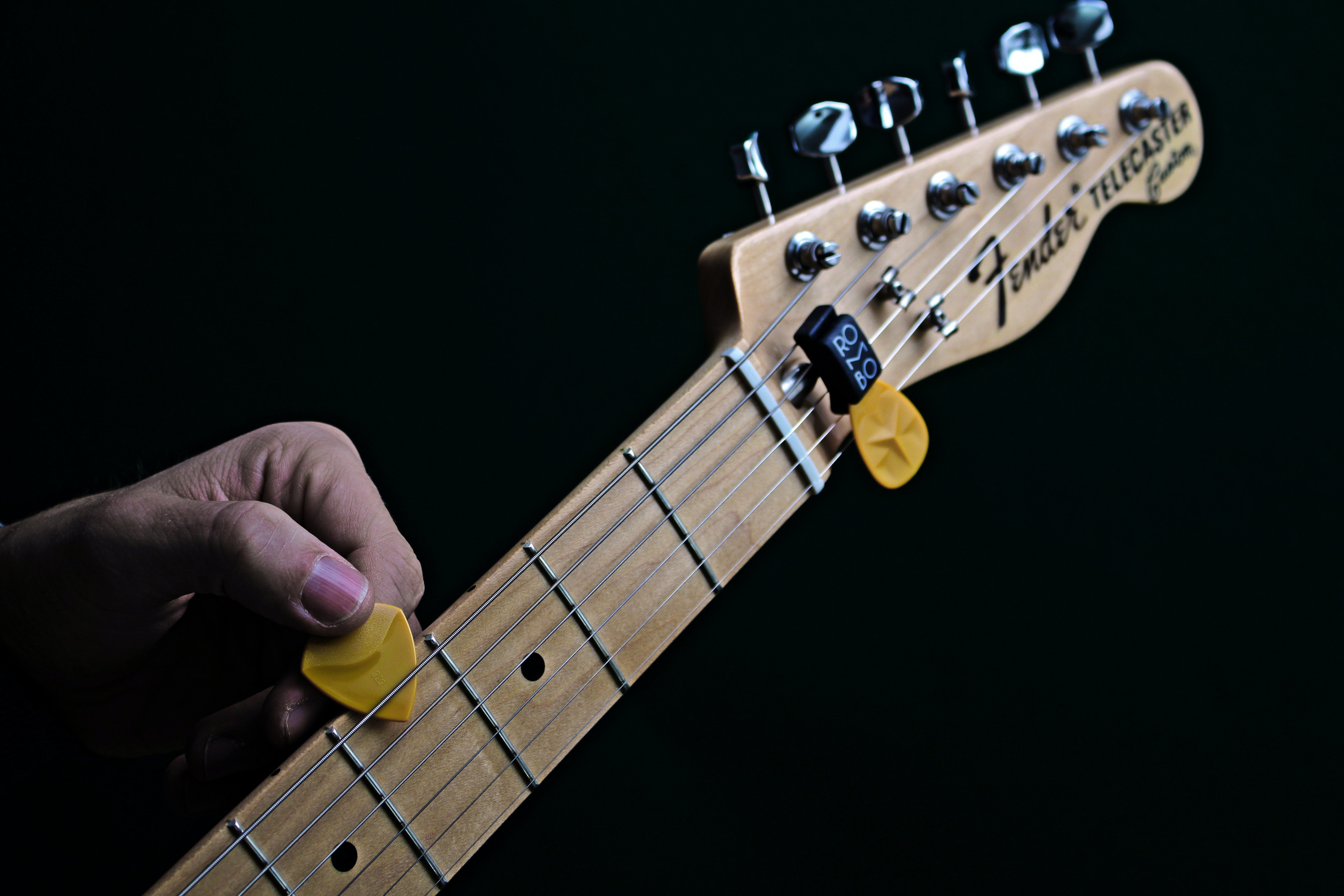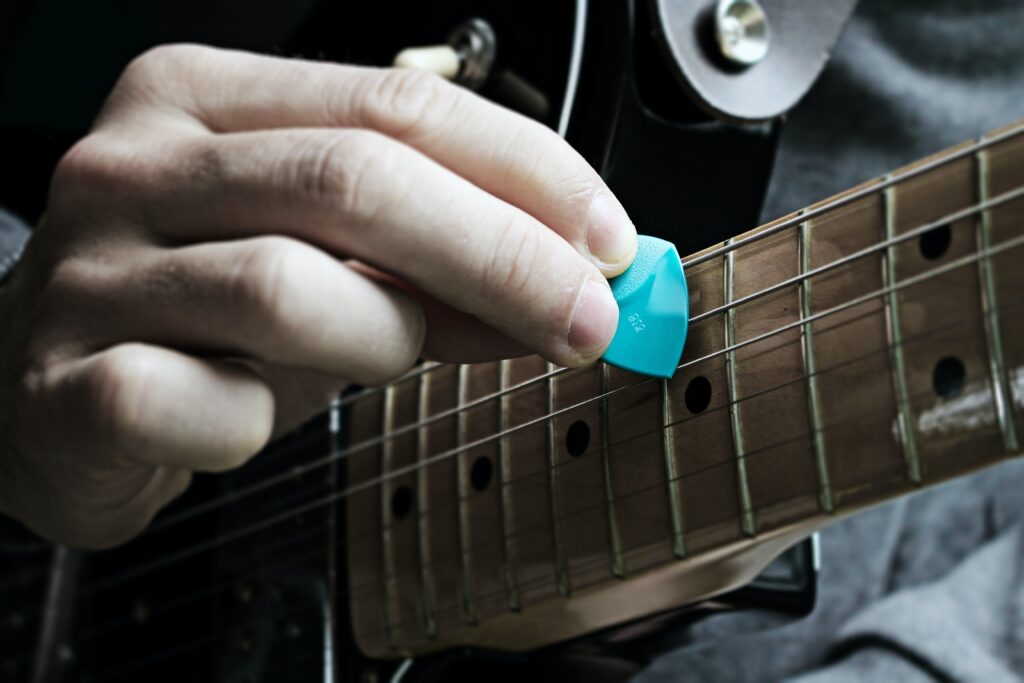If you’re a guitarist, you know how important picks are. They’re small but mighty tools that bring soul and life to your every strum. But what do you do when a pick gets stuck in the strings or inside of your instrument?
Don’t worry – we’ve got the answers on exactly how to get a pick out of a guitar without damaging it! We’ll walk through all the easy steps so that you can have peace of mind knowing that even if one slips away, it’s not gone forever!
How to get a pick out of a guitar correctly?
While it is pretty easy to keep dropping your guitar picks into the guitar, getting them out is not often straightforward. Trying to get the pick out by reaching between the strings can be difficult and not too good for your guitar strings, especially when you don’t have a child to help you do so. Trying to get it by shaking the guitar may also seem funny.
However, learning how to get a pick out of a guitar is not complicated as you can get a guitar pick out either by using just your hands alone or with simple materials.
Here are ways to get your guitar pick out of the guitar.
Using only hands
Getting a guitar pick out using only your hands can be tricky, but is an easy way to get the job done.
The first step in using this technique is getting the guitar pick into a position where you can see it, and the best spot for this is making the pick sit on the inside label.
It would help if you gently shook the guitar until the pick became visible on the top of the label, where the soundhole is. The best way to get this done quickly is by holding the guitar on your lap with the soundhole facing up and the pick visible to you.
Once you have done this, clear the immediate area of people, other guitars, or chairs as enough free space is required. The essential activity comes next.
Hold the guitar securely at the bottom and neck, then flip it upside down in a single swift movement so that the soundhole faces the ground. Once this happens, the guitar pick lands either on the floor or the strings from where you can easily take them out.
Although this technique is easy, it might take a little practice to get a smooth and quick motion. So if you do not get it right the first time, it is best to try again. The key to getting this done correctly is flipping the guitar without letting the pick slide around.
Using simple materials
As an alternative to flipping the guitar decisively to get a pick out, you can also use simple materials. You will need a piece of scotch tape, a pencil, or a chopstick for this process.
First, make a tape bubble from a few inches of the tape. Making a tape bubble means making a circle with the sticky side of the tape since you will need that. Once you have done this, attach the tape bubble with the sticky side still out to the eraser end of the pencil or the thick end of your chopstick.
The next step is to hold your guitar on your lap with the soundhole facing up to see the pick. Then get your pencil or chopstick between the strings and the soundhole’s side, after which you use it to slowly and carefully take your guitar pick out.
To make things easy, keep the tool handy in case it happens again.
| Method | Description |
|---|---|
| Use your Fingers | Reach in and try to pinch the pick with your fingers, then gently pull it out. |
| Use Tweezers | Use tweezers to carefully grip the pick and pull it out. Be careful not to scratch the guitar. |
| Use a Pen or Pencil | Insert a pen or pencil through the soundhole and push the pick out from the other side. |
| Use a Vacuum Cleaner | Hold the hose of a vacuum cleaner up to the area where the pick is stuck and let it suction. |
| Use a Piece of Tape | Place a piece of sticky tape over the pick and gently pull it out. |
| Turn the Guitar | Turn the guitar upside down and shake it gently until the pick falls out. |
How do you get a pick out of a pick holder?
Getting a pick out of a pick holder can feel like an impossible task if you don’t know what you’re doing. Fortunately, it doesn’t have to be that difficult! The key is to start slow and gentle – no yanking or tugging.
First, take the pick holder in one hand and lay it on the edge of a flat surface. Make sure not to drop it as this could damage the delicate strings or even bend them out of shape.
Carefully press down on the side of the holder nearest to where the pick is stuck. As you do this, hold onto the pick so that it doesn’t fly out with too much force.
Once you’ve created some space between the two surfaces, try using tweezers or needle-nose pliers to grab onto and pull out the pick. If these tools are unavailable, you can also use your fingernails to gently pry apart the two pieces until the pick is freed from its prison.
If all else fails, try using a lubricant such as cooking oil or WD-40 for extra grip so that you can safely remove your beloved tool without damaging anything. Place a few drops of oil at each side of where the pick is stuck and wait for a few minutes before giving it one final tug – remember again to hold onto both sides as you do this!
How do you not lose your guitar pick?
As a guitar player, losing your pick can be a frustrating experience. It always seems to happen at the worst possible moment, whether you’re in the middle of a performance or practicing a difficult riff.
So, what can you do to make sure you never lose your guitar pick? One simple trick is to keep a few backups with you at all times.
Consider attaching a pick holder to your guitar strap or keeping a few picks in your wallet or phone case. You can also try using a pick grip or choosing a pick with a textured surface for a better grip.
Whatever method you choose, having a plan in place can help ensure that you’re never without a pick when you need it most.
Should you hold a guitar pick tight or loose?
When it comes to holding a guitar pick, the question of “tight or loose” divides many guitar players.
Some say that a lighter grip allows for more control and fluidity in your strumming, while others believe that a firm grip provides a stronger attack and better tone.
Ultimately, the answer may depend on personal preference and playing style. If you find that you’re struggling with accuracy and precision while strumming, you may benefit from a tighter grip.
However, if you’re having trouble generating power or feel like you’re getting stuck on the strings, a looser grip may be the way to go. The important thing is to experiment and find what works best for you and your playing.
How do you strum a pick quickly?
Strumming a pick quickly can require a great amount of skill and practice. To begin, you must develop the correct hand position for strumming.
Place your thumb on the back of the pick to provide stability, while keeping your index and middle fingers just slightly curved around the pick. This will enable you to have better control over the speed and direction of your strum.
In terms of technique, it’s important to focus on short, controlled motions as opposed to long, sweeping ones. Imagine grinding coffee beans with a mortar and pestle: each small movement adds up to create a larger result. The same principle applies when strumming; instead of making large strokes, focus on quick down-and-up movements to achieve maximum speed.
Timing is also key when attempting fast strums; try counting out loud or using a metronome to help maintain a steady tempo. Once you feel comfortable with this rhythm, experiment by relaxing and speeding up your motions until you find what works best for you musically.
Finally, make sure that your wrist stays loose throughout each motion so that there’s no tension in your arms or hands as this can limit dexterity and speed.
What picks are best for strumming?
When it comes to strumming, having the right picks can make all the difference. Some picks are better suited for strumming than others, with characteristics like flexibility, thickness, and shape all playing a role in how well they perform.
Thin picks are generally best for strumming, as they allow for more fluid and natural movements. However, thicker picks can be beneficial for players with a heavier hand or those seeking a brighter tone.
The shape of the pick can also play a part in how effective it is for strumming, with triangle-shaped picks offering a more balanced attack and teardrop-shaped picks providing a smoother sound.
Ultimately, the best pick for strumming will depend on your playing style and personal preference, so don’t be afraid to try out different options until you find one that works for you.
How long do guitar picks last?
Guitar picks can last anywhere from a few weeks to many years, depending on the material it is made of and how well it is taken care of.
Generally speaking, guitar picks are designed to be robust and hard-wearing, but even the most durable pick will eventually wear out over time. Factors such as playing style, string gauge, and frequency of use can all contribute to how quickly guitar picks may need to be replaced.
For most guitarists, plastic picks tend to last the longest with proper care and usage. If a plastic pick is used regularly with medium-gauge strings, it can last for up to several months before needing to be replaced.
On the other hand, metal or steel picks may only last a few weeks due to their much thinner design.
In addition to material considerations, environmental factors can also affect the longevity of your guitar pick. Exposure to humidity or extreme temperatures can cause warping or breakage in some plastics and metals; store your picks away from direct sunlight or damp environments whenever possible.
If you’re looking for a longer-lasting pick that won’t compromise sound quality or performance, consider investing in special materials such as Delrin or Tortex.
These materials are specially designed for durability with a unique blend of stiffness and flexibility that helps them resist wear and tear. With proper care and usage, these specialty guitar picks can last for many years without needing replacement.
Conclusion
Getting a pick out of a guitar is a skill every guitarist will find helpful. Now you know how to get a pick out of a guitar, you would not worry too much when your pick drops into the guitar.





